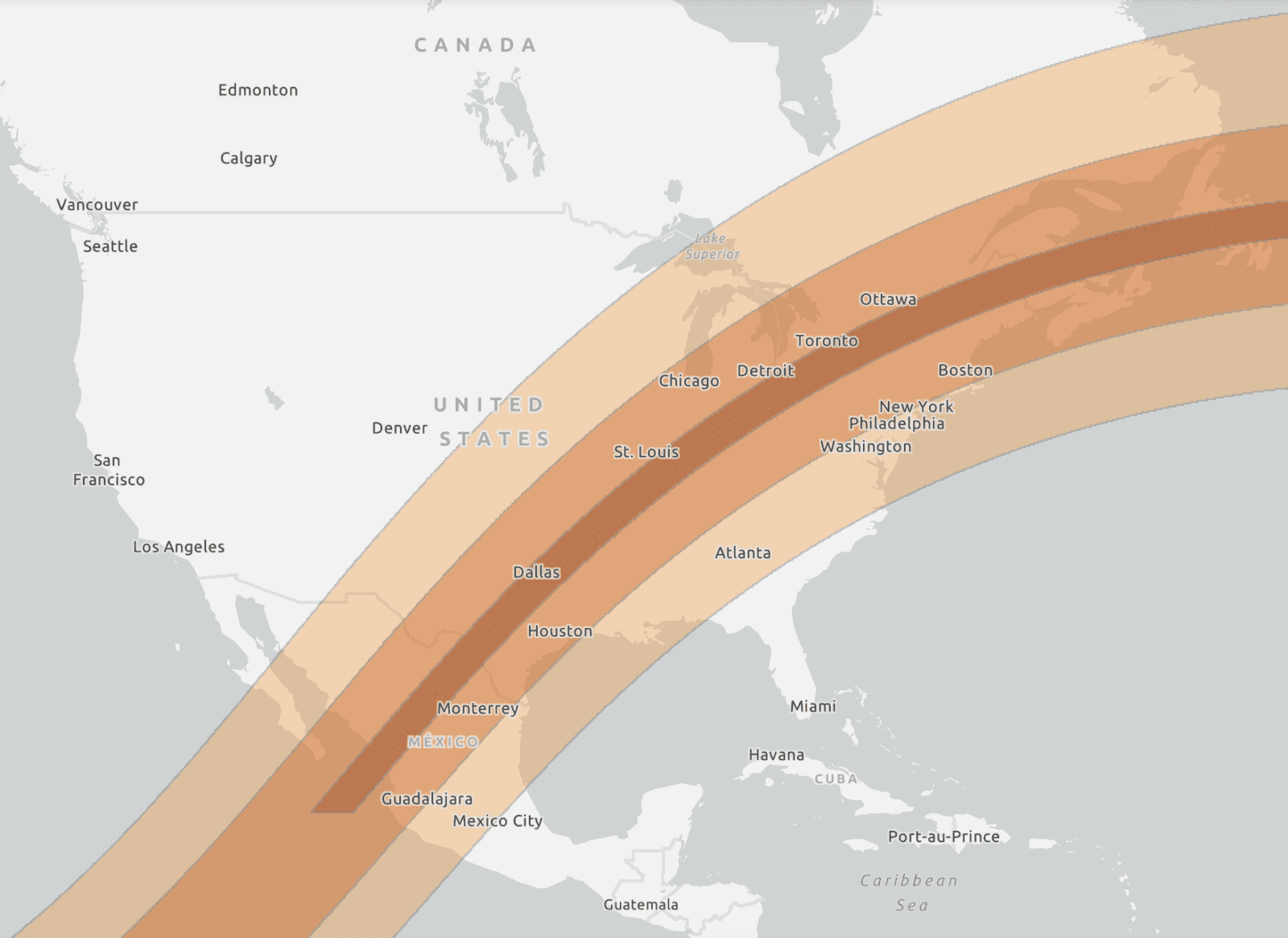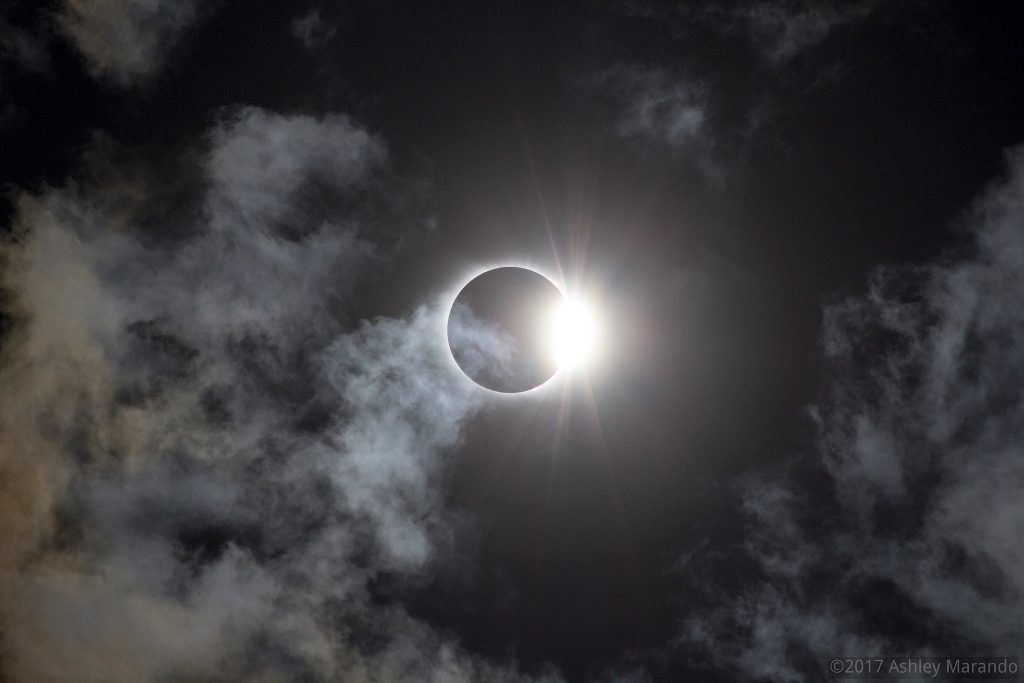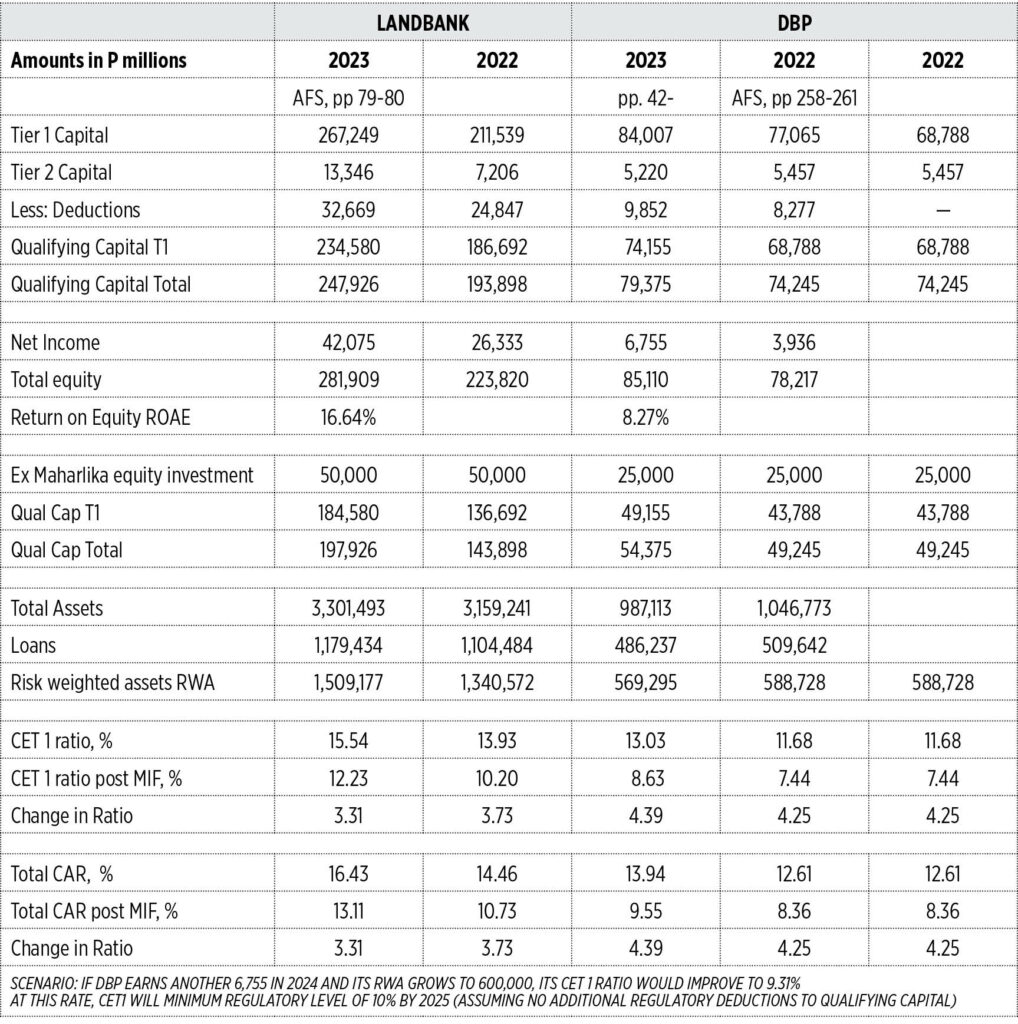On April 8th, 2024, a total solar eclipse will sweep across North America, from Mexico to the Maine-Canadian border. For those who experienced the spectacular solar eclipse of 2017, this one will be similar, crossing the United States from west to east and passing through or near several major metropolitan areas. While its path is quite different this time, Carbondale, Illinois, a reasonable destination for Chicago-area residents, will once again be on the line of totality.
Just a little background on eclipses: Lunar and solar eclipses are not uncommon – they each occur about twice a year when the moon is crossing the ecliptic, the path of the sun in the sky. When the moon is new, we experience a solar eclipse; when it is full, we see a lunar eclipse. For a lunar eclipse, much of the Earth will see totality, assuming clear skies, and totality typically lasts 30 minutes to an hour. But for a solar eclipse, totality is only visible for a narrow band about 70 miles wide and will last for only minutes. Totality can last as long as 7 minutes, but the 2024 solar eclipse will be a little over 4 minutes for much of North America. While the moon will completely cover the sun in the Carbondale area, people viewing from Chicago will see only about 92% of the sun covered by the moon. Cool, but a long way from the awesome experience of totality.
The 2024 solar eclipse will begin on the continent at 11:51 AM Mexico Daylight Time in Mazatlán, Mexico. The shadow will cross the Rio Grande at 12:10 CDT, where San Antonio, Austin, Fort Worth, and Dallas are all in its path. The length of totality will depend on how near you actually are to the centerline of the shade, and the difference can be minutes of totality. From Texas, the eclipse will move up through Oklahoma, Arkansas, Illinois, Kentucky, Ohio, Pennsylvania, New York, Vermont, New Hampshire, and Maine. Along the way, Indianapolis, Cleveland, Buffalo, and Rochester are near the centerline. You can see the path and length of totality using this interactive link.

Credit: Esri, TomTom, Garmin, FAO, NOAA, USGS, EPA, USFWS
So where should you plan your viewing? As a Chicagoan, I watched from a wonderful location near Carbondale in August 2017. However, skies can be cloudy in the Midwest during April, so I am planning on visiting friends in Austin, Texas who have property near the centerline – balancing greater travel distance against the probability of clear skies. Of course, probability is not certainty or even likelihood. Carbondale could be sunny and clear. But wherever you decide to go, you should start to plan lodging soon as accommodations are already filling up.
What can you expect to see?
In the line of totality, you can observe changes as the moon begins to move across the disc of the sun. Slowly the sky and the Earth will darken until it seems dusk is setting in. Do you notice a change in animals, birds halting their songs, cows headed home? How do the shadows around you change? Do colors appear different? Hundreds of tiny eclipsed suns may appear beneath the trees.
In Carbondale, Illinois, first contact of the moon with the sun will be at around 12:45 PM. With safe viewing devices, you can watch the moon cover more and more of the sun, until totality begins at about 2:01 PM. During totality, you can view the sun safely with the naked eye. It is not the intensity of the sun that can damage the eyes but the ultraviolet and infrared radiation emitted by the sun; during totality, the sun’s photosphere is completely covered and only the corona, the sun’s gassy “atmosphere” is visible. In Carbondale, totality will last for about 4 minutes and 10 seconds, although this length will vary across the continent with the longest times in Mexico and Texas and shortest as the eclipse moves towards the northeast. Following totality, the eclipse will play reverse, until final contact at about 3:16 PM in Carbondale, about 2½ hours in all.
If you are lucky enough to be in the path of totality, are there things for which to watch? Do any stars or planets come into view as the sky darkens, especially near totality? For this eclipse, all seven planets will be lined up along the ecliptic near the sun, although Uranus and Neptune will certainly be too dim. (Still this will be a chance to see all of the seven wandering stars identified by the ancients and which named the days of our week. Two of them, the sun and moon will be easy, but bright Venus and Jupiter should be easy to find.)
As the sun moves into totality, there are three phenomena worth noting:
- Bailey’s Bead: As the moon covers the sun, the uneven surface of the moon, mountains and valleys, allows bright beads of light to appear along the edges.
- The Diamond Ring effect is related to Bailey’s Beads, and is a flash along the edge when only one bright bead remains. The flash is like a bright diamond set on the thin ring of the sun.
- The corona: With the sun completely covered, the eclipse can be observed without glasses or other devices. The sun’s corona is its upper atmosphere and is observable to the naked eye only during totality when the sun’s surface, the photosphere, is completely hidden. Prior to our space telescopes, solar eclipses were the only time astronomers could actually study the sun’s atmosphere.
What colors do you see as the sun eclipses? How does the darkness of the sky vary from the eclipsed sun to the horizon? Of course, it is likely that you will be so transfixed by the magic of brief totality that these observations can be easily forgotten in the brief 4 minutes of totality.

Credit Ashley Marando NASA
Viewing devices
Before totality, eclipse glasses are probably the easiest way to safely observe the sun. You can watch the sun from first to last contact safely using them; in fact, you can look at the sun anytime with these glasses, even seeing large sunspots. Don’t wait until next spring to look for eclipse glasses – like lodging, they will be difficult to obtain as we near the eclipse. And make certain you purchase them from a reputable source. They should have a rating of ISO12312-2 to be safe. Observing the sun through sunglasses, film negatives, or the reflection of a mirror or water in a bucket is NOT safe.
Another safe method is to use welder’s glasses of level 14 or darker, if you have them.
Another fun and inexpensive method for observing the eclipse is to make a pinhole projector or a solar projector using binoculars or a telescope on a stand. If you have a telescope, you can purchase a solar filter (but remember, do not look through the viewfinder to find the sun!)
Oh, and another cool way to observe the sun is with a colander or beneath a tree that will project dozens of eclipsing suns on the ground.
During the four minutes or so of totality, you can put all of these viewing aids away and enjoy the wonder of totality, the blackened sun hanging 64 degrees above the southern horizon in Carbondale will be safe to view. However, if you are in Chicago, or another location outside of totality, you must protect your eyes the entire time.
Hopefully the 2024 solar eclipse has been on your calendar and you have already made plans. If not, now is the time. If you miss this eclipse, the next total eclipse to cross the United States will be in August, 2045, with a robust 6 minutes of totality. You may want to mark that on your calendar now – 20 years pass quickly! The rooms may already be filling up.
The post Total Solar Eclipse on April 8, 2024 appeared first on Illinois Science Council.








Leave a Comment